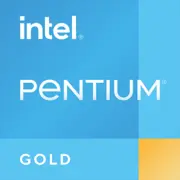Intel Pentium Gold 7505

Intel Pentium Gold 7505: processore economico per compiti quotidiani
Aprile 2025
Architettura e processo tecnologico: 10 nm SuperFin e ottimizzazione per la mobilità
Il processore Intel Pentium Gold 7505, presentato nella linea Tiger Lake, è progettato per laptop economici, dove i fattori chiave sono l'efficienza energetica e la compattezza.
Nuclei, flussi e frequenze di clock
- 2 nuclei / 4 flussi: Frequenza di base - 2.0 GHz, massima in modalità Turbo Boost - fino a 3.5 GHz.
- 10 nm SuperFin: Il processo tecnologico garantisce un minore riscaldamento e un migliore consumo energetico rispetto ai chip a 14 nm delle generazioni precedenti (ad esempio, Pentium Gold 6405U).
Grafica integrata
- Intel UHD Graphics di 11ª generazione: 48 unità di esecuzione (EU), supporto per 4K@60 Hz tramite HDMI 2.0 o DisplayPort.
- Tecnologie: Supporto per la decodifica AV1, utile per lo streaming video, e DirectX 12 per il gaming di base.
Consumo energetico e TDP: equilibrio tra potenza e autonomia
- TDP 15 W: Valore tipico per ultrabook. In condizioni di carico minimo, il consumo scende a 5-7 W.
- Design termico: Consente di utilizzare il raffreddamento passivo in alcuni dispositivi sottili (ad esempio, Chuwi Minibook X).
Prestazioni: cosa può fare il Pentium Gold 7505?
I risultati dei test Geekbench 6 (1353 / 2590) lo collocano a livello dell'Intel Core i3 di 10ª generazione, ma con una migliore efficienza energetica.
Compiti reali
- Lavoro d'ufficio: Gestisce senza problemi il browser (10+ schede), Microsoft Office, Zoom.
- Multimedia: Streaming video 4K su YouTube, montaggio di video semplici in Shotcut (con lag nei casi di effetti complessi).
- Gaming:
- CS:GO - 40-50 FPS a impostazioni basse (720p).
- Minecraft - 50-60 FPS (1080p, grafica minimale).
- Progetti AAA moderni (ad esempio, Cyberpunk 2077) - sconsigliato.
Modalità Turbo Boost
- Carichi brevi (ad esempio, apertura di un PDF pesante): La frequenza sale a 3.5 GHz.
- Carichi prolungati (rendering video): La frequenza si stabilizza tra 2.8 e 3.0 GHz a causa di limitazioni nel raffreddamento.
Scenari di utilizzo: a chi si adatta questo processore?
1. Studenti: Per studio (digitare testi, presentazioni, corsi online).
2. Impiegati d'ufficio: Lavoro con email, fogli di calcolo, applicazioni aziendali.
3. Utenti domestici: Streaming Netflix, social media, videochiamate.
4. Viaggiatori: Laptop compatti con lunga autonomia (ad esempio, Lenovo IdeaPad Slim 3).
Non adatto: A gamer, designer, ingegneri che lavorano con CAD.
Autonomia: quanto durerà il laptop?
- Tempo di funzionamento:
- Navigazione web - 8-10 ore (con batteria da 50 W·h).
- Video - fino a 12 ore (grazie alla decodifica hardware AV1).
- Tecnologie di risparmio energetico:
- Intel Speed Shift: Controllo dinamico delle frequenze.
- C-States: Mettere i nuclei non utilizzati in modalità sleep.
Confronto con i concorrenti
AMD Ryzen 3 5425U (Zen 3, 4 nuclei / 8 flussi)
- Pro: Migliore prestazione multi-thread (Geekbench 6 Multi Core ~3200).
- Contro: Prezzo più alto dei laptop (da $450 contro $350 per il Pentium).
Apple M1 (nei base MacBook Air)
- Pro: Prestazioni 2-3 volte superiori, 18 ore di autonomia.
- Contro: Prezzo a partire da $999, compatibilità limitata con software Windows.
Intel Core i3-1115G4 (2 nuclei / 4 flussi)
- Pro: Frequenze fino a 4.1 GHz, 15-20% più veloce in carichi single-thread.
- Contro: Laptop più costosi di $50-100.
Pro e contro del Pentium Gold 7505
Punti di forza:
- Basso costo dei laptop (da $300).
- Supporto per standard moderni: Wi-Fi 6, Thunderbolt 4 (in alcuni modelli).
- Prestazioni adeguate per compiti quotidiani.
Punti deboli:
- Solo 2 nuclei: La multitasking è limitata (ad esempio, rallentamenti durante l'utilizzo simultaneo di Photoshop e del browser).
- Nessun supporto per PCIe 4.0: Gli SSD funzionano su PCIe 3.0 x4 (fino a 3.5 GB/s).
Raccomandazioni per la scelta di un laptop
1. Tipo di dispositivo: Ultrabook (Acer Swift 1) o laptop compatti (HP 14s-dq).
2. Memoria RAM: Minimo 8 GB (meglio 16 GB per un futuro margine).
3. Storage: SSD obbligatorio (256 GB o più).
4. Schermo: Full HD (1920×1080) - meno affaticamento per gli occhi.
5. Extra: Controllare la presenza di USB-C con supporto per la ricarica.
Esempi di modelli del 2025:
- ASUS Vivobook Go 14 ($329): 8 GB RAM, 256 GB SSD, 14" FHD.
- Dell Inspiron 15 3520 ($349): 8 GB RAM, 512 GB SSD, slot per HDD.
Conclusione: a chi si adatta il Pentium Gold 7505?
Questo processore è una scelta vantaggiosa per chi cerca un laptop economico per compiti di base. I suoi principali vantaggi:
- Prezzo: Dispositivi più economici rispetto agli equivalenti Ryzen 3 o Core i3.
- Efficienza energetica: Fino a 10 ore di lavoro senza ricarica.
- Tecnologie moderne: Supporto Wi-Fi 6, Thunderbolt 4.
Chi dovrebbe acquistarlo:
- Studenti per lo studio.
- Pensionati per comunicazioni e hobby.
- Uffici come dispositivi aziendali.
Chi dovrebbe cercare alternative:
- Gamer: considerare Ryzen 5 o Intel Core i5 con grafica dedicata.
- Freelance: meglio Core i5 / Ryzen 5 e 16 GB RAM.
Fascia di prezzo dei laptop: $300–$400 (nuovi modelli, 2025). Se il vostro budget è superiore a $500, ha senso optare per una CPU più potente.
Di base
Specifiche della CPU
Specifiche della memoria
Specifiche della GPU
Varie
Classifiche
Rispetto ad altre CPU
Condividi sui social media
Oppure linkaci
<a href="https://cputronic.com/it/cpu/intel-pentium-gold-7505" target="_blank">Intel Pentium Gold 7505</a>